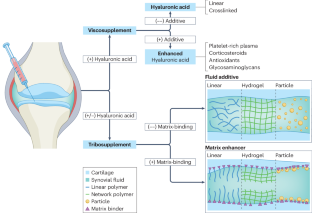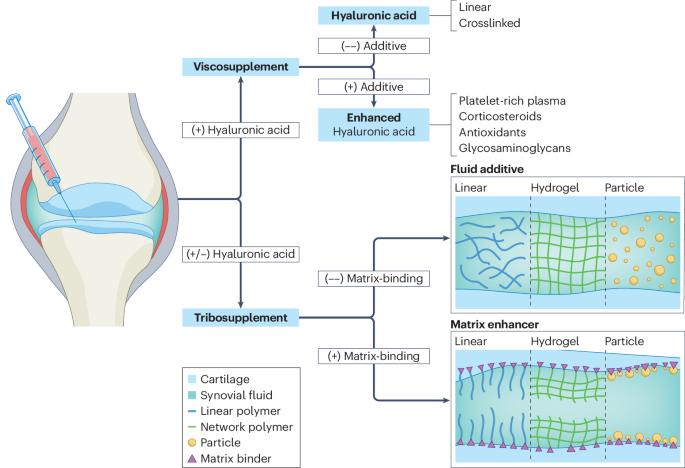Advances in viscosupplementation and tribosupplementation for early-stage osteoarthritis therapy
IF 29.4
1区 医学
Q1 RHEUMATOLOGY
引用次数: 0
Abstract
Joint kinematic instability, arising from congenital or acquired musculoskeletal pathoanatomy or from imbalances in anabolism and catabolism induced by pathophysiological factors, leads to deterioration of the composition, structure and function of cartilage and, ultimately, progression to osteoarthritis (OA). Alongside articular cartilage degeneration, synovial fluid lubricity decreases in OA owing to a reduction in the concentration and molecular weight of hyaluronic acid and surface-active mucinous glycoproteins that form a lubricating film over the articulating joint surfaces. Minimizing friction between articulating joint surfaces by lubrication is fundamental for decreasing hyaline cartilage wear and for maintaining the function of synovial joints. Augmentation with highly viscous supplements (that is, viscosupplementation) offers one approach to re-establishing the rheological and tribological properties of synovial fluid in OA. However, this approach has varied clinical outcomes owing to limited intra-articular residence time and ineffective mechanisms of chondroprotection. This Review discusses normal hyaline cartilage function and lubrication and examines the advantages and disadvantages of various strategies for restoring normal joint lubrication. These strategies include contemporary viscosupplements that contain antioxidants, anti-inflammatory drugs or platelet-rich plasma and new synthetic synovial fluid additives and cartilage matrix enhancers. Advanced biomimetic tribosupplements offer promise for mitigating cartilage wear, restoring joint function and, ultimately, improving patient care. Joint lubrication is important for minimizing friction between articulating joint surfaces and for preventing cartilage wear that can otherwise exacerbate osteoarthritis. This Review examines the advantages and disadvantages of various strategies for restoring normal joint lubrication.


用于早期骨关节炎治疗的粘弹性补充剂和摩擦性补充剂的研究进展
先天性或后天性肌肉骨骼病理解剖或病理生理因素引起的合成代谢和分解代谢失衡造成关节运动不稳定,导致软骨的组成、结构和功能退化,最终发展为骨关节炎(OA)。在关节软骨退化的同时,由于在关节表面形成润滑膜的透明质酸和表面活性粘液糖蛋白的浓度和分子量降低,OA 中的滑液润滑性也会降低。通过润滑最大限度地减少关节表面之间的摩擦是减少透明软骨磨损和维持滑膜关节功能的基础。使用高粘度补充剂(即粘度补充剂)增加滑液的粘度是重建 OA 滑液流变学和摩擦学特性的一种方法。然而,由于关节内停留时间有限和软骨保护机制失效,这种方法的临床效果各不相同。本综述将讨论透明软骨的正常功能和润滑作用,并探讨恢复正常关节润滑作用的各种策略的优缺点。这些策略包括含有抗氧化剂、抗炎药物或血小板丰富血浆的当代粘液补充剂,以及新型合成滑液添加剂和软骨基质增强剂。先进的仿生物三合一补充剂有望减轻软骨磨损、恢复关节功能,并最终改善患者护理。
本文章由计算机程序翻译,如有差异,请以英文原文为准。
求助全文
约1分钟内获得全文
求助全文
来源期刊

Nature Reviews Rheumatology
医学-风湿病学
CiteScore
29.90
自引率
0.90%
发文量
137
审稿时长
6-12 weeks
期刊介绍:
Nature Reviews Rheumatology is part of the Nature Reviews portfolio of journals. The journal scope covers the entire spectrum of rheumatology research. We ensure that our articles are accessible to the widest possible audience.
 求助内容:
求助内容: 应助结果提醒方式:
应助结果提醒方式:


